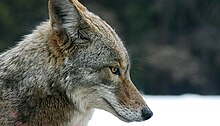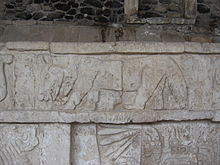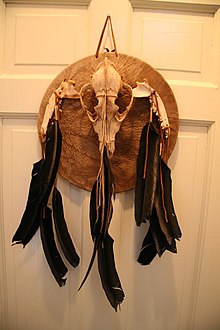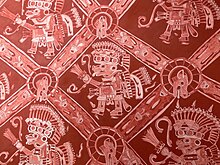The average male coyote weighs 8 to 20 kg (18 to 44 lb) and the average female 7 to 18 kg (15 to 40 lb). Their fur color is predominantly light gray and red or fulvous interspersed with black and white, though it varies somewhat with geography. It is highly flexible in social organization, living either in a family unit or in loosely knit packs of unrelated individuals. It has a varied diet consisting primarily of animal meat, including deer, rabbits, hares, rodents, birds, reptiles, amphibians, fish, and invertebrates, though it may also eat fruits and vegetables on occasion. The coyote's characteristic vocalization is a howl made by solitary individuals. Humans aside, cougars and gray wolves are the coyote's only serious enemies. Nevertheless, coyotes do sometimes mate with gray, eastern, or red wolves, producing hybrids colloquially called "coywolves". In northeastern United States and eastern Canada, a larger species of coyote (although still smaller than the three types of wolves), called the eastern coyote is the result on various historical and recent mating of the various types of wolves and coyotes. Most recent studies show that most wolves contain some level of coyote DNA.
The coyote is a prominent character in Native American folklore, mainly in the Southwestern United States and Mexico, usually depicted as a trickster that alternately assumes the form of an actual coyote or a man. As with other trickster figures, the coyote uses deception and humor to rebel against social conventions. The animal was especially respected in Mesoamericancosmology as a symbol of military might. After the European colonization of the Americas, it was reviled in Anglo-American culture as a cowardly and untrustworthy animal. Unlike wolves (gray, eastern, or red), which have undergone an improvement of their public image, attitudes towards the coyote remain largely negative.
...
Coyote males average 8 to 20 kg (18 to 44 lb) in weight, while females average 7 to 18 kg (15 to 40 lb), though size varies geographically.
...
The color and texture of the coyote's fur varies somewhat geographically. The hair's predominant color is light gray and red or fulvous, interspersed around the body with black and white. Coyotes living at high elevations tend to have more black and gray shades than their desert-dwelling counterparts, which are more fulvous or whitish-gray. The coyote's fur consists of short, soft underfur and long, coarse guard hairs. The fur of northern subspecies is longer and denser than in southern forms, with the fur of some Mexican and Central American forms being almost hispid (bristly). Generally, adult coyotes (including coywolf hybrids) have a sable coat color, dark neonatal coat color, bushy tail with an active supracaudal gland, and a white facial mask. Albinism is extremely rare in coyotes; out of a total of 750,000 coyotes harvested by federal and cooperative hunters between March 22, 1938, and June 30, 1945, only two were albinos.
The coyote is typically smaller than the gray wolf, but has longer ears and a relatively larger braincase, as well as a thinner frame, face, and muzzle. The scent glands are smaller than the gray wolf's, but are the same color. Its fur color variation is much less varied than that of a wolf. The coyote also carries its tail downwards when running or walking, rather than horizontally as the wolf does.
Coyote tracks can be distinguished from those of dogs by their more elongated, less rounded shape.
...
At the time of the European colonization of the Americas, coyotes were largely confined to open plains and arid regions of the western half of the continent. In early post-Columbian historical records, distinguishing between coyotes and wolves is often difficult. One record from 1750 in Kaskaskia, Illinois, written by a local priest, noted that the "wolves" encountered there were smaller and less daring than European wolves. Another account from the early 1800s in Edwards County mentioned wolves howling at night, though these were likely coyotes.This species was encountered several times during the Lewis and Clark Expedition (1804–1806), though it was already well known to European traders on the upper Missouri. Lewis, writing on May 5, 1805, in northeastern Montana, described the coyote in these terms:
The coyote was first scientifically described by Thomas Say, a naturalist, in September 1819 on the site of Lewis and Clark's Council Bluffs, 15 miles up the Missouri River from the mouth of the Platte during a government-sponsored expedition with Major Stephen Long. He had the first edition of the Lewis and Clark journals in hand, which contained Biddle's edited version of Lewis's observations dated May 5, 1805. His account was published in 1823.
...
Hybridization
Coyotes have occasionally mated with dogs, sometimes producing crosses colloquially known as "coydogs". Such matings are rare in the wild, as the mating cycles of dogs and coyotes do not coincide, and coyotes are usually antagonistic towards dogs. Hybridization usually only occurs when coyotes are expanding into areas where conspecifics are few, and dogs are the only alternatives. Even then, pup survival rates are lower than normal, as dogs do not form pair bonds with coyotes, thus making the rearing of pups more difficult
...
Coyote pups are born in dens, hollow trees, or under ledges, and weigh 200 to 500 g (0.44 to 1.10 lb) at birth. They are altricial, and are completely dependent on milk for their first 10 days. The incisors erupt at about 12 days, the canines at 16, and the second premolars at 21. Their eyes open after 10 days, by which point the pups become increasingly more mobile, walking by 20 days, and running at the age of six weeks. The parents begin supplementing the pup's diet with regurgitated solid food after 12–15 days. By the age of four to six weeks, when their milk teeth are fully functional, the pups are given small food items such as mice, rabbits, or pieces of ungulate carcasses, with lactation steadily decreasing after two months. Unlike wolf pups, coyote pups begin seriously fighting (as opposed to play fighting) prior to engaging in play behavior. A common play behavior includes the coyote "hip-slam". By three weeks of age, coyote pups bite each other with less inhibition than wolf pups. By the age of four to five weeks, pups have established dominance hierarchies, and are by then more likely to play rather than fight. The male plays an active role in feeding, grooming, and guarding the pups, but abandons them if the female goes missing before the pups are completely weaned. The den is abandoned by June to July, and the pups follow their parents in patrolling their territory and hunting. Pups may leave their families in August, though can remain for much longer. The pups attain adult dimensions at eight months, and gain adult weight a month later.[21]
Territorial and sheltering behaviors[
Individual feeding territories vary in size from 0.4 to 62 km2 (0.15 to 24 sq mi), with the general concentration of coyotes in a given area depending on food abundance, adequate denning sites, and competition with conspecifics and other predators. The coyote generally does not defend its territory outside of the denning season, and is much less aggressive towards intruders than the wolf is, typically chasing and sparring with them, but rarely killing them. Conflicts between coyotes can arise during times of food shortage.[21]
Like wolves, coyotes use a den (usually the deserted holes of other species) when gestating and rearing young, though they may occasionally give birth under sagebrushes in the open. Coyote dens can be located in canyons, washouts, coulees, banks, rock bluffs, or level ground. Some dens have been found under abandoned homestead shacks, grain bins, drainage pipes, railroad tracks, hollow logs, thickets, and thistles. The den is continuously dug and cleaned out by the female until the pups are born. Should the den be disturbed or infested with fleas, the pups are moved into another den. A coyote den can have several entrances and passages branching out from the main chamber. A single den can be used year after year.[
Hunting and feeding behaviors ]
While the popular consensus is that olfaction is very important for hunting, two studies that experimentally investigated the role of olfactory, auditory, and visual cues found that visual cues are the most important ones for hunting in red foxes and coyotes.
When hunting large prey, the coyote often works in pairs or small groups. Success in killing large ungulates depends on factors such as snow depth and crust density. Younger animals usually avoid participating in such hunts, with the breeding pair typically doing most of the work. Unlike the wolf, which attacks large prey from the rear, the coyote approaches from the front, lacerating its prey's head and throat. Like other canids, the coyote caches excess food. Coyotes catch mouse-sized rodents by pouncing, whereas ground squirrels are chased. Although coyotes can live in large groups, small prey is typically caught singly. Coyotes have been observed to kill porcupines in pairs, using their paws to flip the rodents on their backs, then attacking the soft underbelly. Only old and experienced coyotes can successfully prey on porcupines, with many predation attempts by young coyotes resulting in them being injured by their prey's quills. Coyotes sometimes urinate on their food, possibly to claim ownership over it
...
In folklore and mythology
The coyote features prominently as a trickster figure in the folktales of America's indigenous peoples, alternately assuming the form of an actual coyote or a man. As with other trickster figures, the coyote acts as a picaresque hero which rebels against social convention through deception and humor. The coyote was likely given its trickster role in light of the actual animal's intelligence and adaptability; pre-Columbian American people observed its behavior, and their folkloric representations reflected its attributes. After the European colonization of the Americas, it was reviled in Anglo-American culture as a cowardly and untrustworthy animal.Unlike the gray wolf, which has undergone a radical improvement of its public image, cultural attitudes towards the coyote remain largely negative.
The coyote plays a role in various mythologies and creation myths of Native American folklore. It is variously credited for having brought fire to humanity, releasing the bison into the world, and of having slain monsters by petrifying them. The Maidu creation myth has the coyote introducing work, suffering, and death to the world. Zuni folklore has the coyote bringing winter into the world by stealing light from the kachinas. Some tribes, such as the Chinook, Maidu, Paiute, Pawnee, Tohono O'odham, and Ute portray the coyote as the companion of the creator. In the Paiute creation myth, the coyote was created by the wolf as a companion, and the two created land by piling soil on the water-covered world. A Tohono O'odham flood myth has the coyote helping Montezuma survive a global deluge that destroys humanity. After the Great Mystery creates humanity, the coyote and Montezuma teach people how to live. The Crow creation myth portrays Old Man Coyote as the creator. In Navajo mythology, the coyote was present in the First World with First Man and First Woman, though a different version has it being created in the Fourth World. The Navajo coyote brings death into the world, explaining that without death, too many people would exist, thus no room to plant corn.
Prior to the Spanish conquest of the Aztec Empire, the coyote played a significant role in Mesoamerican cosmology. The coyote symbolized military might in Classic era Teotihuacan, with warriors dressing up in coyote costumes to call upon its predatory power. The species continued to be linked to Central Mexican warrior cults in the centuries leading up to the post-Classic Aztec rule. In Aztec mythology, Huehuecóyotl (meaning "old coyote"), the god of dance, music and carnality, is depicted in several codices as a man with a coyote's head. He is sometimes depicted as a womanizer, responsible for bringing war into the world by seducing Xochiquetzal, the goddess of love. Epigrapher David H. Kelley argued that the god Quetzalcoatl owed its origins to pre-Aztec Uto-Aztecan mythological depictions of the coyote, which is portrayed as mankind's "Elder Brother", a creator, seducer, trickster, and culture hero linked to the morning star.







No comments:
Post a Comment